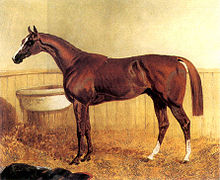John Frederick Herring senior
John Frederick Herring, Sr. (* 1795 in London , † 1865 in Meopham near Tonbridge ), also known as John Frederick Herring I , was a British painter in Victorian England. He added "SR" (senior) to his signature in 1836 when one of his four sons, John Frederick Herring Jr. , also became known as a painter.
Life
Herring was born in London in 1795 ; he was the son of a London merchant of Dutch descent, a native of the United States . Herring spent the first 18 years of his life in London, his interests were horses and painting. In 1814, at the age of 18, he moved to Doncaster in the north of England. A year later, Herring married Ann Harris; his sons, John Frederick Herring Jr., Charles Herring and Benjamin Herring also became artists, while his two daughters, Ann and Emma, married painters.
In Doncaster, Herring painted restaurant signs and the outside of carriages. He then got a job as a coachman. In his spare time he painted portraits of horses for restaurants and was known as the “artist coachman” during this time. His talent was recognized by wealthy clients and he began painting hunters and racehorses for British society.
In 1830 John Frederick Herring left Doncaster and moved to Newmarket, where he lived for three years before moving to London. There Herring suffered from financial difficulties and received support from WT Copeland, who commissioned many paintings and used some designs for his porcelain Copeland Spode bone china. The acquaintance of the successful painter Abraham Cooper helped him to develop his artistic skills . In 1840 and 1841 he painted several pictures during a visit to Paris at the invitation of the Duc d'Orleans, son of the French King Louis-Phillipe .
In 1845 Herring painted animal pictures for the Duchess of Kent. Orders from the ruling Queen Victoria , who supported him until the end of his life, followed.
In 1853 Herring moved to the rural county of Kent in southeast England; from this point on he stopped painting portraits of horses. He spent the last twelve years of his life in Meopham Park near Tonbridge, where he lived as a country gentleman. There he expanded his subjects to include rural scenes and the well-known hunting images.
As a highly successful and productive artist, Herring ranks on the same level as Sir Edwin Landseer as one of the most important animal painters in the mid-19th century. His paintings were very popular, particularly the 33 winners of the St Leger horse race in Doncaster and the 21 winners of the Derby race. Herring exhibited at the Royal Academy of Arts between 1818 and 1865, at the "British Institution" from 1830 to 1865 and at the "Society of British Artists" between 1836 and 1852, where Herring became Vice President in 1842.
Herring created hundreds of paintings, which were widely recognized during his lifetime. His paintings are exhibited in the Tate Gallery , London, among others .
See also
- George Stubbs - horse painter
Individual evidence
- ↑ John Frederick Herring, Jr. (1820–1907) (overview), Rehs Galleries, 2007, website: Rehs-JFH-Jr .
Web links
| personal data | |
|---|---|
| SURNAME | Herring, John Frederick Sr. |
| ALTERNATIVE NAMES | Herring, John Frederick I. |
| BRIEF DESCRIPTION | British painter in Victorian England |
| DATE OF BIRTH | 1795 |
| PLACE OF BIRTH | London |
| DATE OF DEATH | 1865 |
| Place of death | Meopham at Tonbridge |


